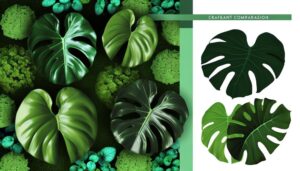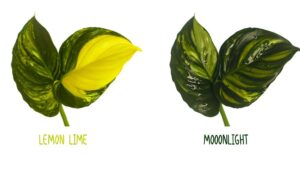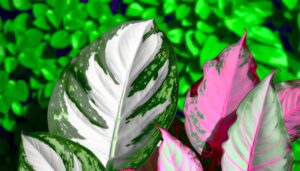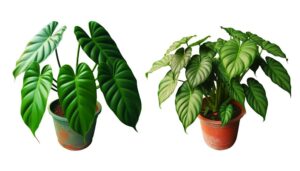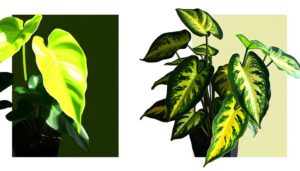Philodendron Imperial Red Vs Rojo Congo: Key Differences!
Philodendron Imperial Red and Rojo Congo, both from the Araceae family, are distinguished by their leaf morphology and growth patterns. Imperial Red features elongated, ovate, deep burgundy leaves with a smoother texture, forming a compact, self-supporting structure.
In contrast, Rojo Congo exhibits heart-shaped leaves shifting from red to dark green, adopting a spreading habit with longer internodes requiring support. Both prefer bright, indirect light, consistently moist but well-draining soils, and high humidity.
Each cultivar’s visual allure and horticultural specifics invite further exploration into their unique characteristics and care requirements.
Key Differences Between Philodendron Imperial Red and Rojo Congo
| Feature | Philodendron Imperial Red | Philodendron Rojo Congo |
|---|---|---|
| Leaf Color | Dark green with deep red undersides | Dark green with red hues when new |
| Leaf Shape | Oval-shaped | Broad and elongated |
| Growth Habit | Compact and upright | Spreading and bushy |
| Size | Medium-sized (up to 3 feet) | Larger-sized (up to 4 feet) |
| Stem Color | Reddish | Reddish-green |
| Light Requirements | Bright, indirect light | Medium to bright, indirect light |
| Watering Needs | Moderate, allow topsoil to dry out | Moderate, keep soil consistently moist |
| Temperature Tolerance | Prefers warm temperatures | Prefers warm temperatures |
| Humidity Requirements | High humidity | Moderate to high humidity |
| Growth Rate | Moderate | Fast |
| Propagation | Stem cuttings | Stem cuttings |
| Common Uses | Indoor decoration, offices | Indoor decoration, large spaces |
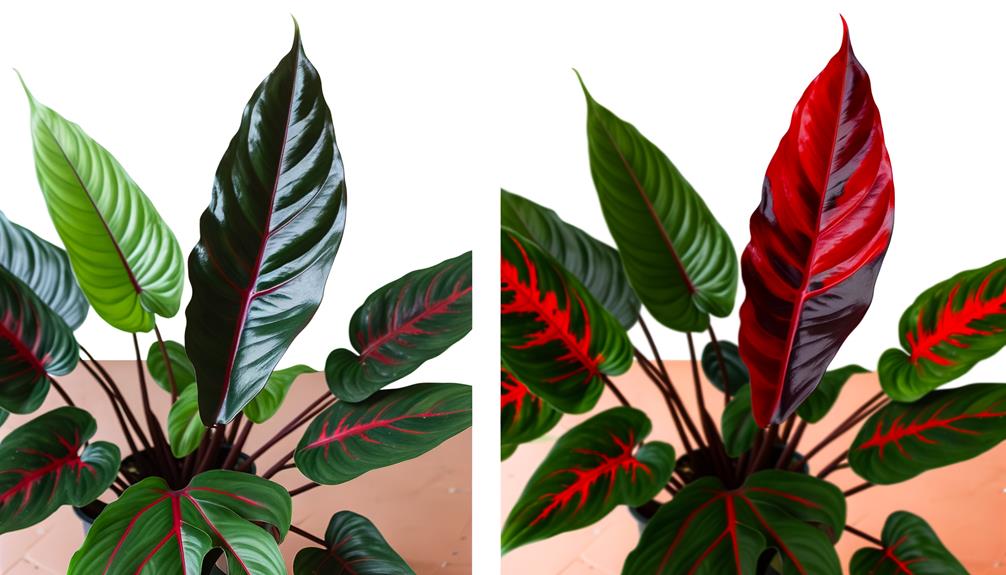
Origin and Background
Philodendron Imperial Red and Rojo Congo, both belonging to the Araceae family, originate from tropical regions in South America, where they thrive in the understory of rainforests. These species are adapted to low light conditions, benefiting from the dappled sunlight filtering through the dense canopy above.
The Philodendron genus is characterized by its climbing or trailing growth habit, facilitated by aerial roots that anchor to tree trunks. Both cultivars are derived from naturally occurring species, selectively bred for their ornamental appeal. Their adaptation to the humid, warm, and shaded environments of their native habitat makes them well-suited for indoor cultivation.
The ecological niche they occupy involves nutrient-rich, well-draining soils, contributing to their robust growth and resilience.
Leaf Shape and Color
In examining the leaf morphology, the Imperial Red exhibits elongated, ovate leaves with a glossy, deep burgundy hue, whereas the Rojo Congo displays broader, heart-shaped leaves that change from a rich red to a dark green as they mature.
The Imperial Red’s leaves are characterized by their lanceolate form and vibrant, persistent coloration, which contributes to its striking aesthetic. In contrast, the Rojo Congo’s leaves are reniform, evolving through a spectrum of colors as they develop, which adds dynamic visual interest.
Additionally, the leaf texture of the Imperial Red is noticeably smoother compared to the slightly more rugged surface of the Rojo Congo. These distinct foliar traits underscore the unique appeal of each Philodendron cultivar within ornamental horticulture.
Growth Habit
Exhibiting a compact, self-supporting growth habit, the Imperial Red maintains a neat, upright formation, whereas the Rojo Congo demonstrates a more expansive, spreading growth pattern, often necessitating additional support for best vertical development.
The Imperial Red’s internodes are shorter, contributing to its dense appearance and making it ideal for limited spaces. Its robust stems provide structural integrity without external assistance.
In contrast, the Rojo Congo’s longer internodes and broader leaf span create a more voluminous canopy. This species benefits from staking or similar support mechanisms to achieve optimum growth.
Both philodendrons display vigorous growth under ideal conditions, yet their structural differences dictate distinct horticultural needs, impacting their suitability for varying spatial arrangements and aesthetic preferences.
Light Requirements
The Philodendron Imperial Red and Rojo Congo exhibit distinct preferences in light requirements, impacting their photosynthetic efficiency and overall health.
Best light conditions for these species typically involve bright, indirect light, though they also demonstrate varying degrees of shade tolerance.
Understanding these light preferences is essential for ensuring best growth and vibrant foliage in both cultivars.
Optimal Light Conditions
Understanding the ideal light conditions for Philodendron Imperial Red and Rojo Congo is crucial for promoting their strong growth and vivid foliage. Both cultivars thrive in bright, indirect light, which mimics their native understory environment.
Direct sunlight should be avoided as it can cause photodamage, appearing as leaf scorch and chlorosis. Best placement is near an east or north-facing window where they receive filtered light. Artificial grow lights with a balanced spectrum can also supplement natural light, ensuring a consistent photoperiod.
Monitoring light intensity using a lux meter can be beneficial; perfect levels range between 10,000 to 20,000 lux. Proper light conditions enhance photosynthetic efficiency, leading to robust, vibrant leaves and overall plant health.
Shade Tolerance Levels
Shade tolerance in Philodendron Imperial Red and Rojo Congo is a critical factor, as both species exhibit remarkable adaptability to low-light environments, though prolonged exposure to deep shade may hinder ideal growth.
Philodendron Imperial Red, characterized by its deep red juvenile leaves, can thrive with filtered light or semi-shade, preventing photoinhibition. Similarly, Rojo Congo, with its broad, glossy foliage, performs well under indirect light, yet may develop etiolation in excessively shaded conditions.
Both plants necessitate a balance between light and shade to maintain chlorophyll synthesis and best morphological development. Avoiding direct, harsh sunlight is paramount to prevent leaf scorch, while ensuring intermittent bright light supports their photosynthetic and physiological efficiency.
Watering Needs
When addressing the watering requirements of Philodendron Imperial Red and Rojo Congo, it is crucial to take into account the frequency of watering, ideal soil moisture levels, and sufficient drainage needs.
Both species require a balance where the substrate stays consistently moist but not waterlogged, hence avoiding root rot.
Properly aerated and well-draining soil compositions are crucial to guarantee ideal hydration and root health for these tropical plants.
Frequency of Watering
Proper watering for both Philodendron Imperial Red and Rojo Congo involves maintaining consistently moist soil while ensuring adequate drainage to prevent root rot.
The frequency of watering these philodendrons depends on environmental conditions such as temperature, humidity, and light exposure. Typically, during the growing season (spring and summer), these plants may require watering every 7-10 days.
In contrast, during the dormancy period (fall and winter), watering frequency should be reduced to approximately every 14-21 days. It is essential to monitor the top 1-2 inches of soil, allowing them to slightly dry out between waterings.
Overwatering or waterlogged soil can lead to detrimental conditions such as fungal infections and root decay, highlighting the importance of a balanced watering regimen.
Soil Moisture Levels
Maintaining ideal soil moisture levels for Philodendron Imperial Red and Rojo Congo is crucial, necessitating a well-draining substrate that retains sufficient moisture without becoming waterlogged.
Both species thrive in consistently moist, yet not overly saturated soil conditions. Adequate soil moisture is crucial for prime root respiration and nutrient uptake, preventing desiccation or root rot.
Key considerations include:
- Substrate Composition: Blend materials like perlite, peat moss, and orchid bark.
- Moisture Monitoring: Use a soil moisture meter to accurately assess hydration levels.
- Watering Schedule: Adapt based on seasonal variations and indoor climate conditions.
- Surface Drying: Allow the top 1-2 inches of soil to dry before re-watering.
- Environmental Factors: Take into account humidity levels and ambient temperature in watering decisions.
These practices guarantee that both Philodendron varieties sustain vigorous growth and health.
Drainage Requirements
Effective drainage is crucial for the best health of Philodendron Imperial Red and Rojo Congo, making sure that excess water is efficiently expelled to prevent root rot and other moisture-related issues. Both species thrive in well-aerated substrates rich in organic matter, such as a mix of peat, perlite, and bark chips.
Utilizing containers with ample drainage holes is vital to facilitate the outflow of surplus water. Overwatering can lead to anaerobic soil conditions, harmful to root respiration. Employing a layered approach with coarse materials at the pot’s base further enhances drainage efficiency.
Regularly monitoring soil moisture levels and allowing the top inch to dry before rewatering ensures best hydration without the adverse effects of waterlogging.
Soil Preferences
Both Philodendron Imperial Red and Rojo Congo thrive in a well-draining, aerated soil medium rich in organic matter to support their robust root systems. Best soil composition requires a balance that retains moisture but avoids waterlogging, which can lead to root rot.
An ideal mix includes:
- Peat moss for moisture retention and acidity.
- Perlite to enhance aeration and drainage.
- Orchid bark for improving soil structure and preventing compaction.
- Coco coir as a sustainable alternative to peat, offering similar benefits.
- Composted organic matter to provide essential nutrients and improve soil fertility.
This composition ensures that both Philodendron species receive adequate oxygen and nutrients, promoting vigorous growth and preventing common soil-related issues.
Temperature and Humidity
In addition to their specific soil requirements, Philodendron Imperial Red and Rojo Congo also require precise temperature and humidity conditions to thrive at their best. Both species flourish in a controlled environment with temperatures ranging from 65-80°F.
Humidity levels should be maintained between 60-80% to mimic their native tropical habitats. It is vital to avoid cold drafts and sudden temperature fluctuations, which can cause stress to these plants. High humidity levels are essential for preventing leaf desiccation and promoting peak growth.
Below is a comparative table detailing the ideal temperature and humidity ranges for these philodendrons:
| Aspect | Imperial Red | Rojo Congo |
|---|---|---|
| Temperature | 65-80°F (18-27°C) | 65-80°F (18-27°C) |
| Humidity | 60-80% | 60-80% |
| Draft Sensitivity | High | High |
These conditions ensure strong and healthy growth.
Common Pests and Diseases
Philodendron Imperial Red and Rojo Congo are susceptible to a variety of common pests and diseases that can greatly impact their health and aesthetics. These afflictions often manifest through symptoms such as foliar discoloration, necrotic lesions, and stunted growth.
Key concerns include:
- Spider Mites: These arachnids cause stippling and webbing on the undersides of leaves.
- Mealybugs: They excrete honeydew, leading to sooty mold and leaf deformation.
- Scale Insects: These pests form protective coverings, causing chlorosis and leaf drop.
- Root Rot: Typically due to overwatering, resulting in mushy roots and wilting foliage.
- Bacterial Blight: Characterized by water-soaked spots that progress to extensive necrosis.
Effective management includes regular monitoring, maintaining ideal cultural practices, and prompt intervention with appropriate treatments.
Aesthetic Appeal
While addressing pest and disease issues is vital for maintaining plant health, the aesthetic appeal of Philodendron Imperial Red and Rojo Congo remains a primary attraction for horticulturists and plant enthusiasts.
Philodendron Imperial Red is characterized by its striking, deep burgundy foliage that evolves to a rich, dark green as it matures, creating a dynamic visual contrast. The leaves are broad and glossy, enhancing its ornamental value.
In contrast, Rojo Congo exhibits a robust, upright growth habit with larger, more elongated leaves that emerge with a reddish-brown hue and gradually turn to a deep green. Both species exhibit a lush, tropical appearance, but the Imperial Red’s color transformation and the Rojo Congo’s stature and leaf size offer distinct visual experiences.
Black Cardinal Philodendron Imperial Red vs. Rojo Congo
Black Cardinal Philodendron Imperial Red:
- Appearance: Features deep burgundy to nearly black leaves, with a glossy texture. The new leaves emerge as a reddish-brown color and darken as they mature.
- Growth Habit: Compact and slow-growing, making it ideal for indoor spaces.
- Light Requirements: Prefers bright, indirect light but can tolerate lower light conditions.
- Care: Requires well-draining soil, regular watering (allowing the soil to dry out between waterings), and moderate humidity.
Rojo Congo:
- Appearance: Exhibits large, broad leaves that start as a burgundy color and mature to a deep green with a reddish tint. The leaves are also glossy and have a vibrant look.
- Growth Habit: More robust and faster-growing compared to Black Cardinal, reaching a larger size.
- Light Requirements: Thrives in bright, indirect light but can adapt to medium light conditions.
- Care: Similar care needs with well-draining soil, regular watering, and moderate to high humidity.
Key Differences:
- Size: Rojo Congo grows larger and faster than Black Cardinal.
- Leaf Color: Black Cardinal has darker, almost black leaves, while Rojo Congo’s leaves are deep green with a reddish hue as they mature.
- Growth Habit: Black Cardinal is more compact and slow-growing, making it more suitable for smaller indoor spaces, whereas Rojo Congo is more vigorous.
Both plants are excellent choices for adding color and texture to your indoor plant collection, with the choice depending on your preference for size and leaf color.
Conclusion
Comparing Philodendron ‘Imperial Red’ and ‘Rojo Congo‘, distinct differences emerge in leaf morphology, growth patterns, and environmental preferences.
‘Imperial Red’ exhibits more compact growth and darker foliage, while ‘Rojo Congo’ boasts larger, more robust leaves.
Both require similar care regarding light, watering, and soil; however, ‘Rojo Congo’ is slightly more tolerant of varying conditions.
Like two sides of the same coin, these philodendrons offer unique aesthetic and horticultural attributes, making them valuable additions to any botanical collection.

